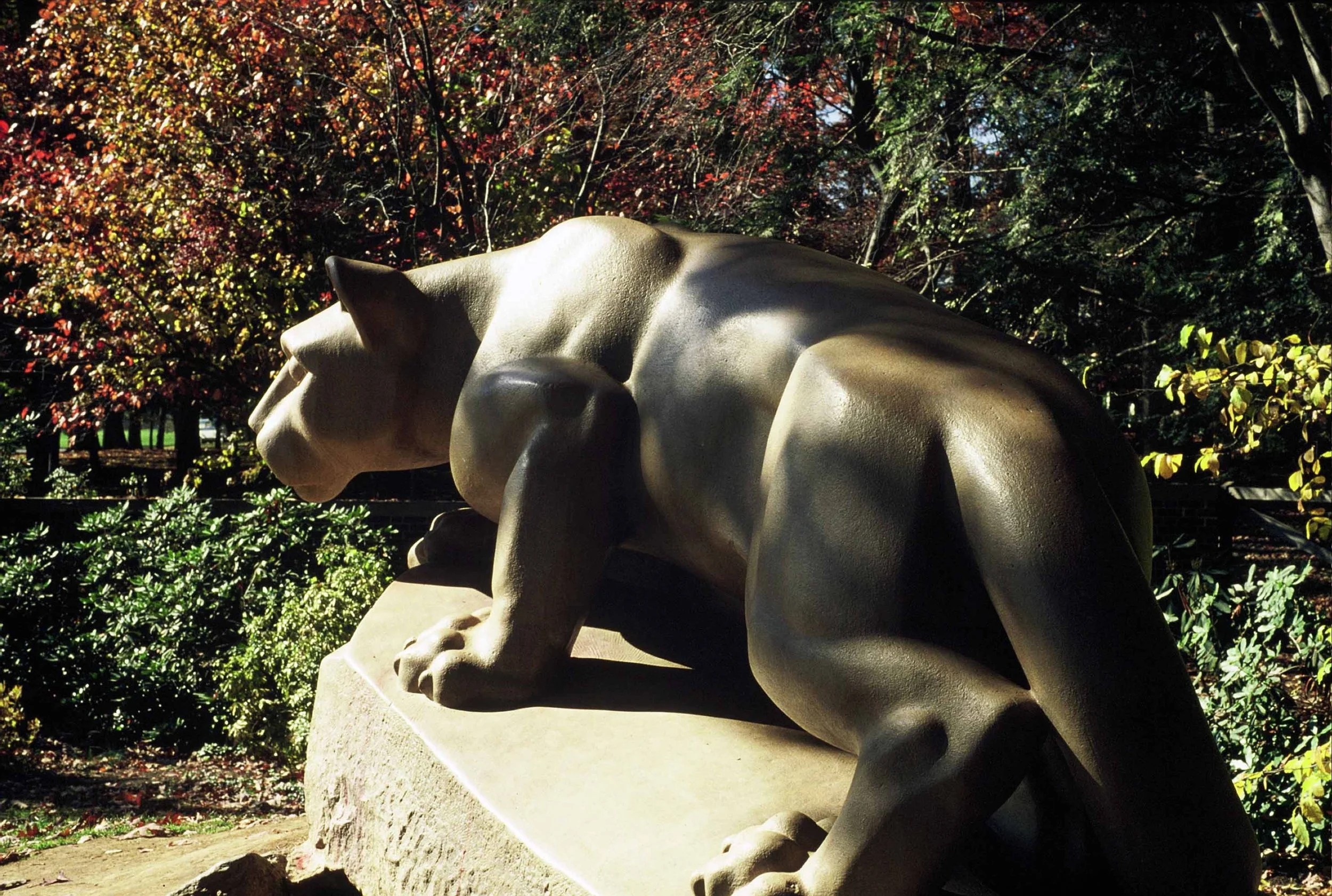
The Nittany Lion
The Nittany Lion Legend—
The legend of the Penn State Nittany Lion dates to spring 1904 and the varsity baseball team. In the late 19th and early aughts of the 20th century, nicknames were commonly bestowed upon teams by newspapermen or opponents who may not have always had the best interests of the college at heart. The athletic teams from Penn State College were sometimes called the “White & Blue”, or the alliterative, but inaccurate, “Boys from Bellefonte”, and sometimes, simply the “Nittanymen” or the “S Men” in reference to the large, white block-letter “S” sewn on their sweaters. Although accurate, the “S Men” nickname was said to be unpopular with the Boys from State, and thankfully none of those early “noms de sport” would permanently stick in State College. What would stick was the nickname from a story that was told at the April 20, 1904 baseball game at Princeton. Penn State player Joe Mason of the Class of 1907, in reaction to the tiger mascot of Princeton, supposedly spun the tale of a fierce beast that would become the Nittany Lion. Mountain lions had once roamed Pennsylvania and specifically Mt. Nittany near State College but had reportedly been extinct in the area since the late 19th century. Still, the tale was told and, possibly more critically, Penn State beat the Tigers, 8-1, to help the lion legend take hold. Interestingly though, the Penn State La Vie yearbook covering the 1904 baseball season utilized cartoon art for the victory over Princeton showing a large dog swallowing a tiger, so the legend didn’t take hold immediately. Note: Another aspect to the Mason story that isn’t often mentioned, is that Mason supposedly got the inspiration for his “lion’s tale” from a taxidermy lion (see below) that was kept in “original” Old Main in this era. (FYI-The Alumni Association uses the April 20th baseball game date as the “official birthday” of the Nittany Lion).
The concept of a lion becoming the Penn State athletic symbol took about 3 more years to brew. It would be the fall of 1907 before the Nittany Lion became the official nickname of Penn State College. And it then would take years, actually decades, until everyone finally agreed that the Nittany Lion was, in fact, a mountain lion and not an African lion with a mane. Early depictions of a lion in publications such as the yearbook would show an African lion with a mane called “Old Nittany” (see photo below with Coach Hugo Bezdek and his 1920 Nittany Lions). And Penn State opponents would depict the Nittany Lion with a mane in game day publications into the early 1980’s. It didn’t help the matter that Penn State itself used a “maned” lion as its sports mascot on and off from 1922 until 1975. Even in the 21st century, some “throwback” athletic logos incorporate an African male lion with a mane. Generally, however, all “official” trademark lion logo art used by the University, the athletic department, the Alumni Association, and the Nittany Lion Club has been based on mountain lions or the Nittany Lion Shrine.
The Nittany Lion Shrine—
The creation of the Nittany Lion Shrine in 1942 might have been the key to visually establishing the idea of the Nittany Lion as a mountain lion. Carved by sculptor Heinz Warneke in what has remained its permanent on-campus location, the Nittany Lion Shrine (a gift of the Class of 1940) is one of the most iconic collegiate symbols in the country. Placed in a natural, treed setting in the then-heart of the athletics area of the campus (the co-called corner of Rec Hall and now long-gone New Beaver Field), the Shrine is probably the most-visited and most-photographed location at Penn State. Warneke, along with stonecutter Joseph Garatti, carved and sculpted the Shrine over a 4-month period out in the open. They began with a 13-ton block of Indiana limestone. The total cost of the project was reportedly $6,000 (approximately $122,000 in 2025 money).
The completed Shrine was dedicated on Oct. 24, 1942, at halftime of the Homecoming/Dad’s Day game vs. Colgate. Contemporary newspaper reports suggest that the ceremony was relatively brief and low-key with little fanfare due to ongoing World War II. Joe Mason, the inventor of the Nittany Lion story, was said to be on hand for the dedication. The football game itself, a 13-10 Penn State win just next door at Beaver Field, drew around 11,500 fans, well below the 16-thousand stadium capacity of the era. (FYI-There was a large Plaster-of-Paris model of the Nittany Lion Shrine that was displayed indoors on campus in early 1942 to give folks an idea of what the completed sculpture would look like. Reportedly, the model later appeared outside the Philadelphia Museum of Art for the International Sculpture Show in the summer of 1949).
CLICK HERE FOR THE INTERESTING HISTORY OF NITTANY LION SHRINE VANDALISM
The Nittany Lion Shrine has appeared on Penn State football jerseys on special occasions only. The Shrine has been used at the front base of the collar on all Nike-made “Generations of Greatness Game” jerseys (both blue and white collar styles) since this gameday theme debuted in 2017 (see below for original 2017 example). The Shrine replaces the official oval lion logo that has occupied this location on jerseys since 2013.
Actual “taxidermy mountain lions” have been displayed at various campus locations over the years and one can still be seen in the All-Sports Museum at Beaver Stadium (see photo above). It purportedly was shot by a hunter on Mt. Nittany in the 19th century and can be found on the mezzanine at the top of the stairs. This lion is called “The Original Nittany Lion” and was housed at one point in Pattee Library and possibly earlier at original Old Main (which might connect it to Joe Mason’s original “lion’s tale” in 1904). Two other taxidermy mountain lions that were taken by two Penn State alums hunting in Colorado in 1923 and presented to the college president in November 1924 were reportedly kept at Varsity Hall (now Irvin Hall in West Halls) which had just opened as the new athletics team house in the Tri-Dorms that fall. They eventually moved to Rec Hall after it opened in January 1929. The whereabouts of those 2 lions is unknown. But an article by Ross Lehman that appeared in the Beaver Stadium Pictorial for the 1967 Pitt game (based in part on a 1949 item in the Penn State Alumni News) suggested that the two Colorado lions had become moth-eaten over time and had fallen into disrepair—hinting that those two lions had likely been disposed of long before 1967. (FYI-Other taxidermy lions exist on campus in non-public spaces such as the Football Letterman’s Club and Lasch Football Building).
CLICK HERE FOR THE STORY OF THE NITTANY LION MASCOT
Did Penn State ever have a “live” lion mascot like LSU’s Mike the Tiger, Bevo the Texas Longhorn, Colorado’s Ralphie the Buffalo, or Uga the Bulldog at Georgia? The answer is no. Although, live lions were used in publicity photo shoots with the team on location in Miami before the 1969, 1970 & 1974 Orange Bowls
CLICK HERE FOR THE HISTORY OF NITTANY LION LOGOS
Nittany Notes:
The Nittany Lion Shrine was first mentioned in Penn State’s football game day program, Beaver Field Pictorial, on Oct. 3, 1942 which was that season’s opener vs. Bucknell. There was a feature story with photos ahead of the planned Oct. 24 dedication of the now iconic Heinz Warneke limestone sculpture. The Shrine itself did not appear on the cover of that program (or the dedication day one 3 weeks later) because, until 1950, Penn State (like many colleges) subscribed to generic professional cover art. The Shrine would first appear on the cover of BFP for the 1952 Purdue game (in a photo with team captains Joe Gratson and Stew Sheetz). It was the 10th anniversary of the sculpture, but oddly, no mention of that was made in the program that day.
For a great cover photo and good reading on the Lion Shrine, check out the Beaver Stadium Pictorial from the 1967 Pitt game. Jerry Gearhart’s photo of the misty, backlit Lion under the lights is one of the best PSU game day covers ever. It celebrates the 25th anniversary of the Shrine and features an article on the varied stories behind the Nittany Lion legend by Ross Lehman of the Alumni Association (see below).
If you’re keeping score, the Nittany Lion Shrine got a 50th anniversary mention on the 1992 BSP cover for the Boston College game, but no photo, not even an inset—the cover photo went to running back Richie Anderson.








